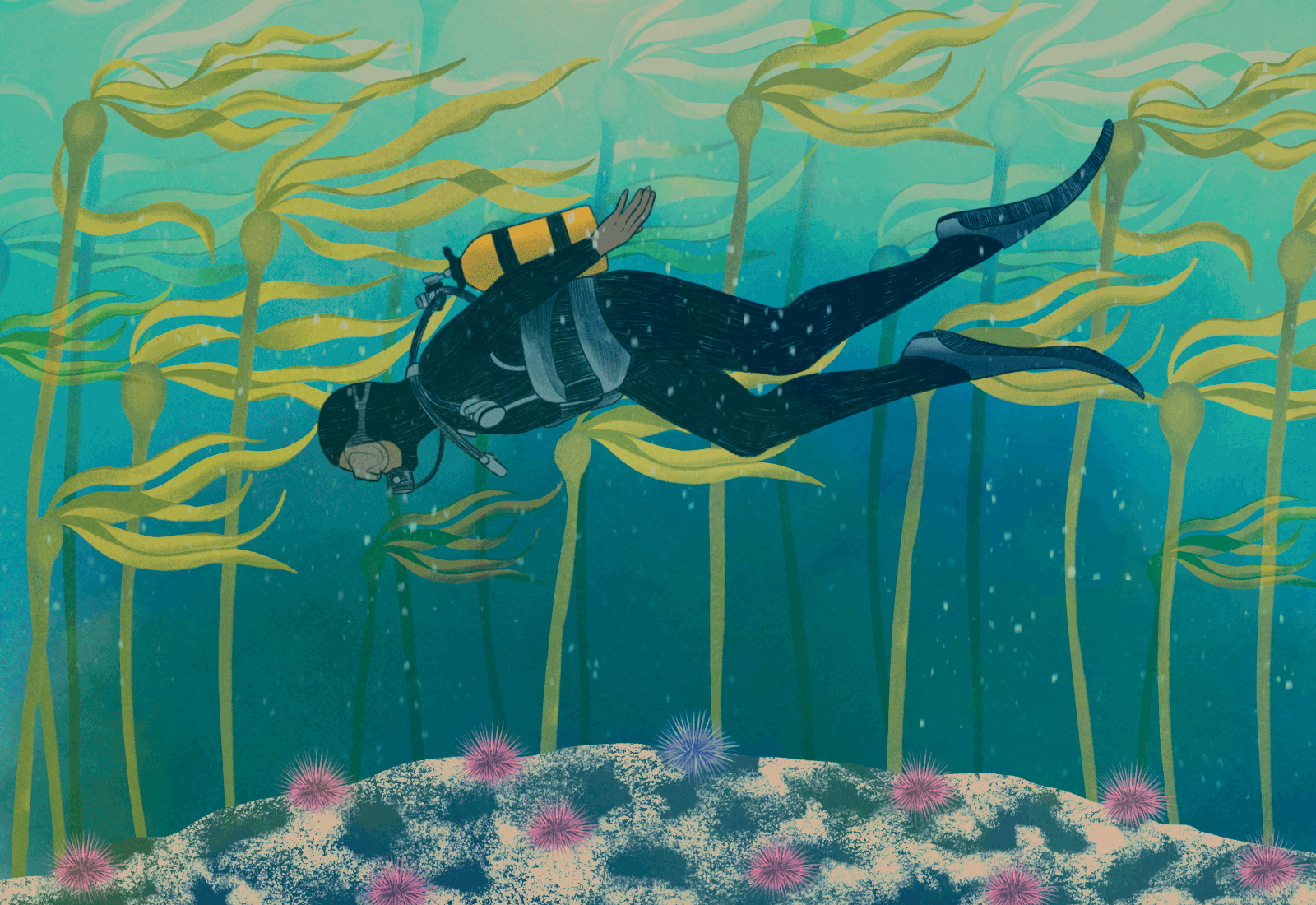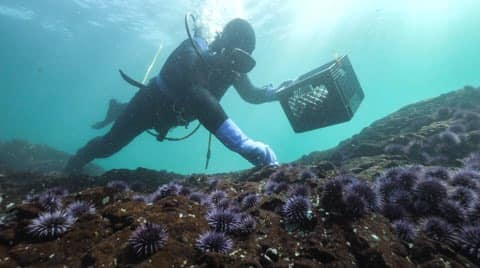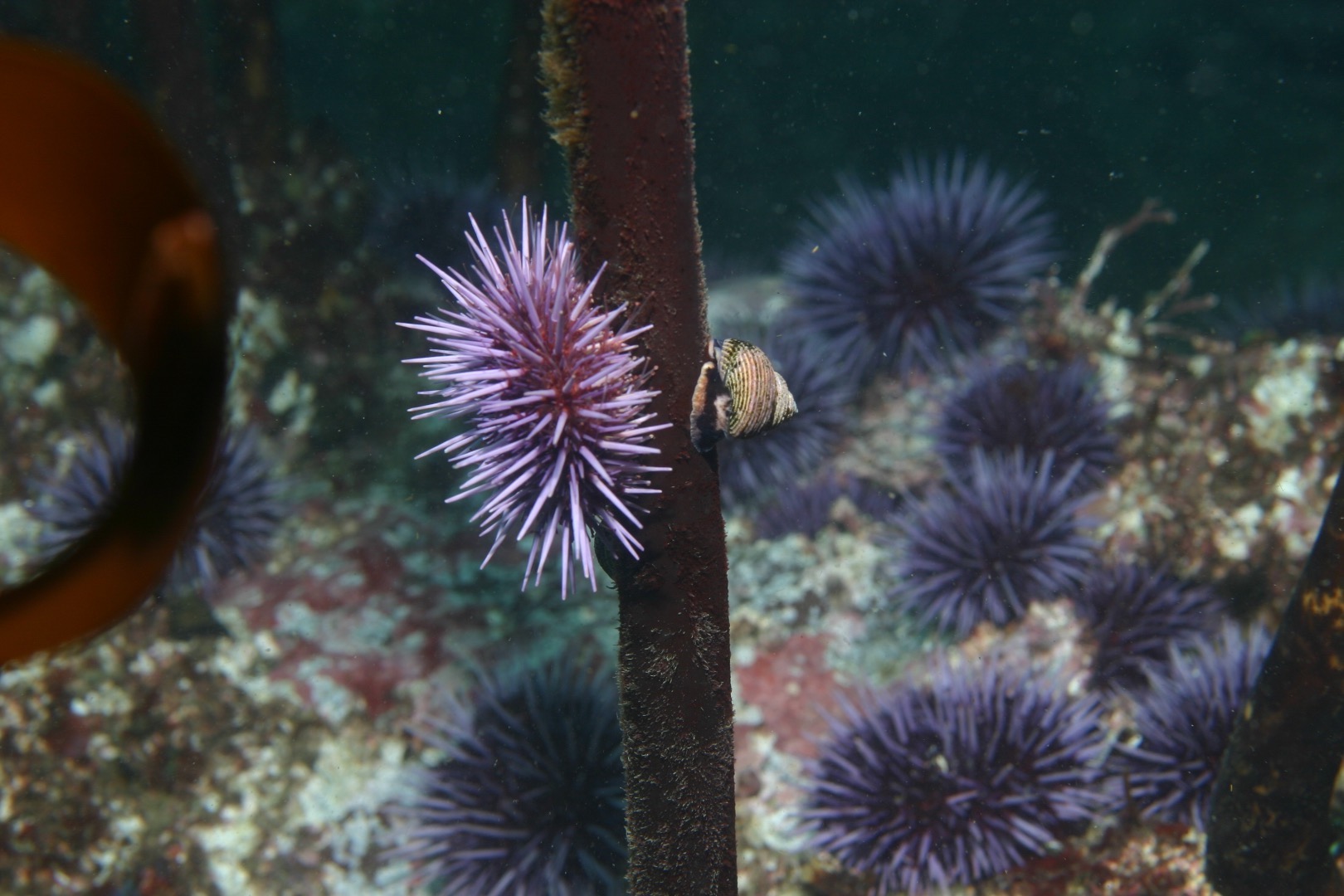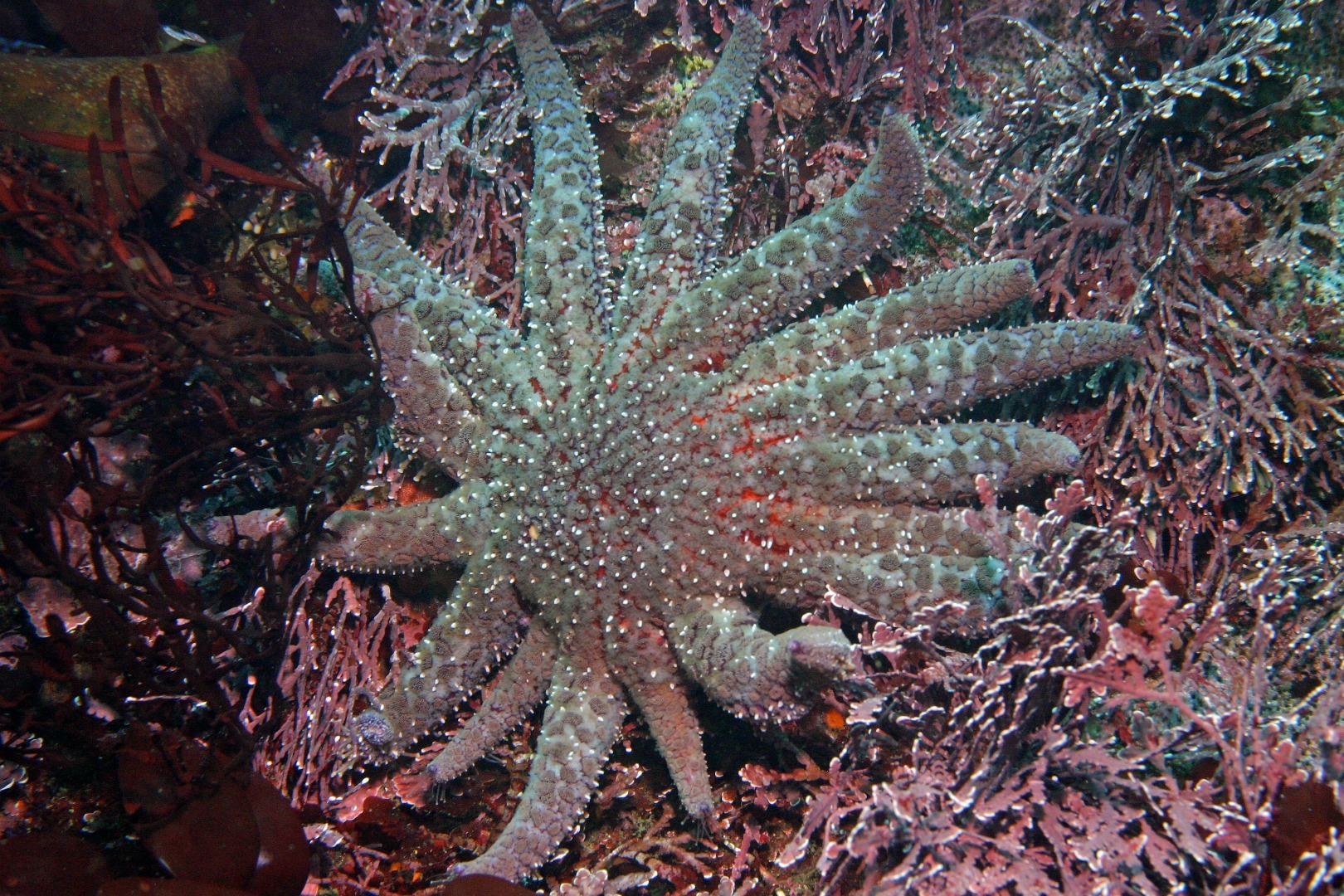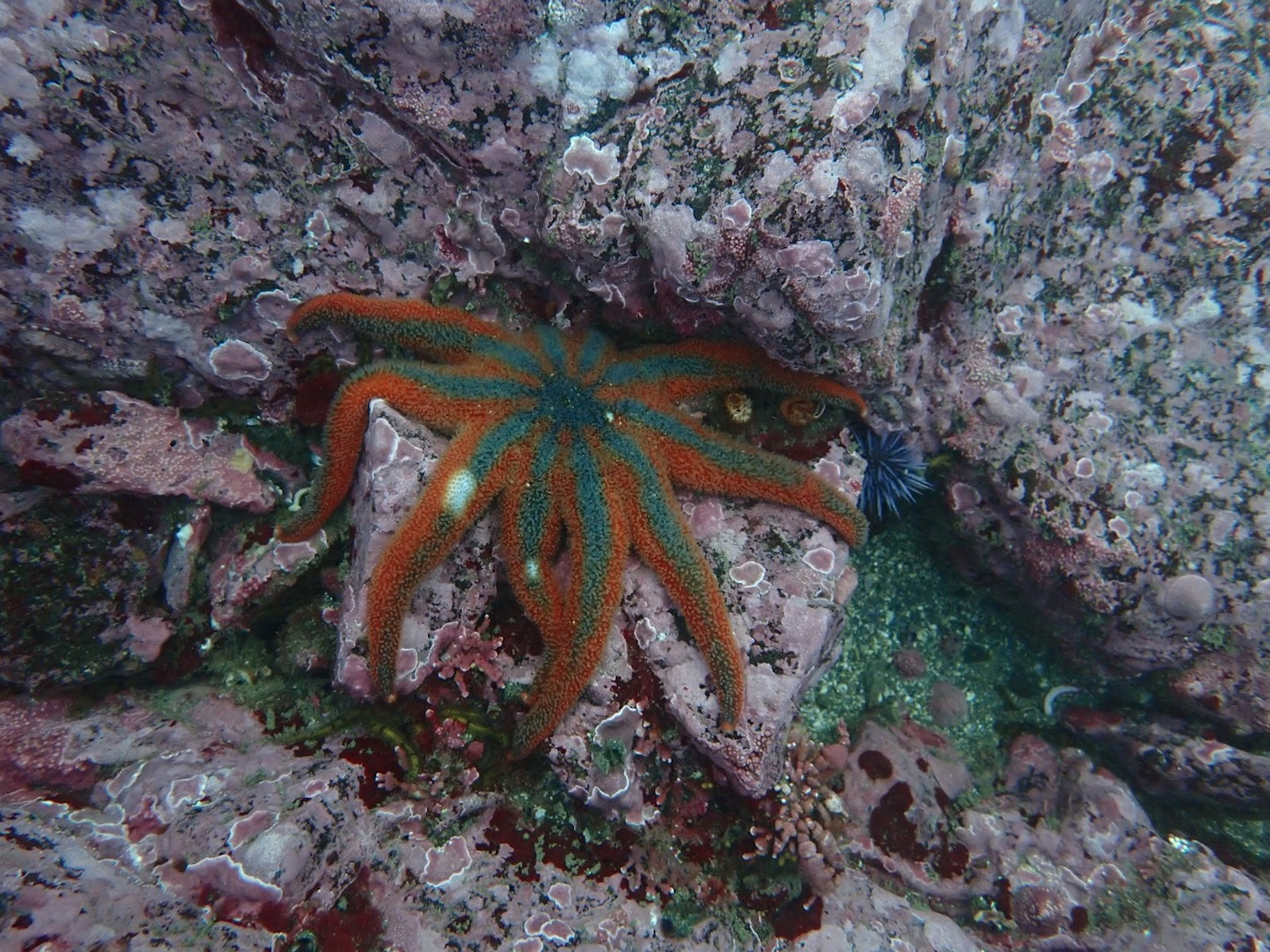Grant Downie had been out of the Pacific Ocean for about 10 minutes when he realized he could no longer see out of his right eye.
The second-generation commercial diver had been deeper beneath the waves than usual searching for his catch — red sea urchins prized by restaurateurs for their uni, or sushi-grade gonads. But the red urchins, which dwell in underwater kelp forests, had gotten harder to find in recent years; each additional foot of depth forced more nitrogen into his bloodstream and upped his risk for dangerous bubbles lodging in his body or brain.
This time, with half of his vision a wall of black, he feared he’d finally pushed his body too far. Though his right eye regained its function 20 minutes later, the 33-year-old decided he was done with such risky dives, even if the decision would end up costing him income.
“I knew that was it for me,” Downie said last March, about seven months after the incident, which took place off the coast of Fort Bragg in Northern California. “I’ll probably go down to 65 feet, but I don’t know if I’ll do that deep, deep edge. It’s getting harder and harder for the guys that are still trying to go.”
Anyone who depends upon California’s kelp forests for their living can tell you that something is very wrong below the surface of the Pacific. It’s not just the red urchin population that is on the decline. Gone is much of the kelp, the dense, autumn-toned canopies of seaweed that once provided food, shelter, and safer haven to hundreds of marine species — from sea otters to abalone, rockfish to brittle stars. Where lush strands of giant kelp or whip-like bull kelp once swayed, entire swaths of the underwater forests have been razed to nubs by one particular predator: the purple urchin.
Grant Downie, left, loads a crate with purple urchins (right) during a culling event in Fort Bragg, California. Photos by Grist / Sierra Rose Garcia, Steve Lonhart / NOAA MBNMS.
People sometimes refer to purple urchins as the “zombies” of the sea — a result of their prodigious hunger and formidable survival skills. (They can survive in “starvation” mode for years). Resembling spiky, baseball-sized pom-poms, purple urchins are omnivorous, consuming everything from plankton to dead fish. But they are particularly fond of kelp, and can chew through the holdfasts that anchor each strand to the seafloor.
The resulting “urchin barrens,” as divers call them, can stretch hundreds of miles, with scientists reporting earlier this year that some Northern California kelp forests have suffered 95 percent loss since 2012.
Kelp are key to much of the West Coast’s marine biodiversity. Like terrestrial forests, kelp (technically a form of brown algae) are important carbon sinks, converting sunlight and carbon dioxide into leaves and canopies. But unlike trees, which return much of that carbon to the atmosphere as they decompose, dead kelp has the potential to sink down to the bottom of the sea, providing a natural form of sequestration. With the kelp forests razed to nubs and starving urchins lying in wait on the seafloor, that cycle has been severely disrupted.
“We’re losing really critically important systems, which means losing fisheries, losing recreational opportunity, losing carbon sequestration, losing coastal protection,” said Fiorenza Micheli, a marine ecologist and co-director of Stanford’s Center for Ocean Solutions. “This is basically the equivalent of losing the rainforest — except we don’t see it.”
Parts of the West Coast have seen as much as a 10,000 percent increase in purple urchins over a five-year period. The huge numbers of “purps,” as commercial divers call them, have shaken communities along the coasts of California and southern Oregon. As a result, many kelp-lovers — commercial fishermen, recreational enthusiasts, scuba divers, and scientists, to name a few — have grown increasingly desperate to take the purple sea urchin infestation into their own hands, often armed with hammers and dive knives.
But in people’s haste to do something about the disappearing kelp, some scientists say those demanding action are losing sight of the fact the purple urchins are a symptom of a much bigger problem. After all, the indefatigable invertebrates were not always the villains of undersea horror stories.
Before the purple urchin explosion, the kelp forest was good to commercial divers and coastal communities alike. In the 1970s, new processing techniques and access to quick shipping allowed American fisheries to start exporting red urchins to Japan. The resulting urchin “gold rush” attracted many commercial divers to California’s Central Coast, including Grant Downie’s father, Patrick, who arrived in the late 1980s. In 2000, the recreational abalone diving industry contributed an estimated $17 million toward local economies; commercial red urchins raked in a state average of $2.6 million per year from 2011 to 2015.
Growing up, Grant Downie saw firsthand how much money commercial divers could make gathering red urchins. In his 20s, he was lucky enough to get a permit (they are awarded by lottery) to join the industry. For years, the two Downies would descend into the Fort Bragg kelp forest to gather red urchins, breathing compressed air through long, thin, flexible air tubes connected to one of their boats above. In just two years, the younger Downie was able to pay off his trade school loans. He even purchased a house before he hit the age of 30.
“We had a bunch of golden years,” the senior Downie told the Press Democrat, a newspaper in Santa Rosa, California, in 2019. “It’s just steadily got worse and worse and worse, because there is no kelp.”
The decline of the West Coast’s kelp forests started around 2013, when a mysterious disease called “sea star wasting syndrome” wiped out 90 percent of the purple urchin’s main predator, the sunflower sea star, in a matter of weeks. The disease existed before that mass die-off, but researchers say its sudden spread was likely linked to warming ocean temperatures and resulting low marine oxygen levels: As seawater heats up, it can’t hold as much gas, including dissolved oxygen, which sea stars absorb directly through their skin to breathe.
Sunflower sea stars, like this one (left) seen in California’s Carmel Bay, used to be one of the main predators of purple urchins. But a mysterious disease called sea star wasting syndrome (seen as white patches on the right) led to a massive die-off along the West Coast, starting in 2013. Photo by Steve Lonhart / NOAA MBNMS, Tristin McHugh / Reef Check CA.
Higher ocean temperatures also directly hurt the kelp strands’ ability to grow. Many kelp species love cold water, and rely on the nutrients it carries to regrow quickly after natural setbacks like winter storms. Typically, that cold, deeper water will rise to the surface each year, essentially bathing kelp forests in natural fertilizer. But if the surface layer gets too hot, the warm water acts like a lid that the deeper, more nutritious cold water can’t penetrate.
Around the same time that sea star numbers began to plummet, West Coast purple urchin populations experienced two excellent breeding years. Under normal circumstances, purple urchins are mostly benign scavengers, helping to clear the seafloor of broken kelp and other detritus. That changed when their numbers suddenly skyrocketed. Even though kelp normally grows fast, the heat-weakened marine forests couldn’t keep pace with the purple urchins’ appetites. Soon Northern California kelp forests were being replaced by urchin barrens.
Unfortunately for commercial urchin divers like the Downies, purple urchins do not have the same value as their red cousins, which compete for the same resources to thrive. As a result, California red urchin fisheries — along with those associated with other kelp-dependent species, such as abalone — have been thrown into sharp decline.
Fort Bragg, where Grant Downie and his father live, has been hit particularly hard. The docks, once bustling with hundreds of red urchin divers and packers, have all but emptied.
Last year, when I traveled to the town of roughly 7,000 people, I met Jaime Pat, the only remaining employee of the dozens of dockworkers who used to process freshly caught red urchins. Everyone else left to find work elsewhere, he told me. With no small hint of pride, he showed off the long counters where the prized red urchin gonads would be scooped out, arranged, and packaged on ice to ship to sushi restaurants.

Downie has also lost a lot of work, but he can still be found sheathed in thick neoprene and on the hunt. In addition to searching for precious red urchins (at what he considers to be reasonable depths), he also gathers purps on occasion. But while red urchin uni is considered a delicacy, there isn’t an equivalent major market for the purple urchin. That’s not a problem for Downie, though, since his mission isn’t to sell the purps he collects for consumption.
It’s to destroy them.
Last September, I accompanied commercial divers on two small fishing vessels out of Fort Bragg — one belonging to the Downies, the other festooned with large Trump 2020 flags. A nonprofit called Reef Check had brokered an agreement with California’s Ocean Protection Council, part of the state’s Natural Resources Agency, to hire the out-of-work red urchin divers to clear all purple sea urchins from a tiny section of shallow seafloor.
The idea was to see whether kelp would then regrow.
The boats had barely left the harbor when each pair of divers submerged, bags and buckets in hand, with the goal of filling massive baskets on the end of the boats’ winches. The purps were so plentiful in the allotted corner of the cove that some divers used rakes and hooks to bag them more efficiently than gathering by hand. (One diver, not present that day, even likes to use an underwater vacuum.) With those tools, a pair of seasoned fishermen can bring in well over 1,000 pounds of purple urchins in a single afternoon. I watched as the day’s baskets quickly filled up, the offending creatures’ spines still waving in languid protest.

Back at the docks, Jaime Pat winched urchin-filled mesh bags the size of Mini Coopers out of the divers’ boats and into giant plastic crates. Nearby, scientists counted and weighed a sample of each load, taking notes on the purps’ size and anatomy before knifing open the spiny husks. The spiny corpses were then taken by the truckful to a compost facility further inland.
For eager purple urchin killers, the event marked a major milestone. It had taken years for divers in the region to chip away at state-imposed restrictions preventing anyone from gathering purps in large batches. The community had posted hundreds of public comments and signed multiple petitions trying to secure permission for professionals and citizens alike to clear all the urchins from small areas of the coast.

But until 2020 — two years after the kelp’s demise had closed the North Coast recreational abalone fishery, and five years after it had closed the regional commercial red urchin fishery — purple urchins were still subject to strict catch limits set by the California Fish and Game Commission.
As hard as it was for divers around Fort Bragg to get approval for a small-scale urchin removal effort from the California Fish and Game Commission, community members along other parts of California’s coast have faced even more pushback. In Monterey Bay, more than 200 miles south of Fort Bragg, agonized kelp lovers tried for years to launch similar culls as patches of urchin barrens began spreading along California’s Central Coast region.
“What will it take for you to declare an emergency?” demanded an attendee of an April 2020 public forum hosted by the Fish and Game Commission about local catch limits. “What will you tell the fishermen?”
Unlike Fort Bragg’s kelp forests, which are only subject to state protections, Monterey Bay includes part of a national marine sanctuary — effectively, an underwater national park. At least on paper, allowing even limited purple urchin smashing in these sanctuaries would be roughly akin to letting enthusiastic backpackers stab Yosemite beavers, if said beavers were threatening to devour every tree inside the park. The unintended, if ironic result: The more protected a marine area, the more at risk it may be for purple urchin-driven destruction.
For three years, trying to convince coastal officials to let divers and scientists descend and destroy purple urchins in Monterey Bay was essentially Reef Check volunteer Keith Rootsaert’s part-time job. The mustachioed scientific diver, who works as a contractor by day, gave countless presentations on the kelp situation to policymakers. He accumulated graphs and maps and data galore, which he used to painstakingly build the case for more aggressive interventions along the Central Coast, even as the remaining kelp in the area began vanishing from some of the West Coast’s most famous dive sites.
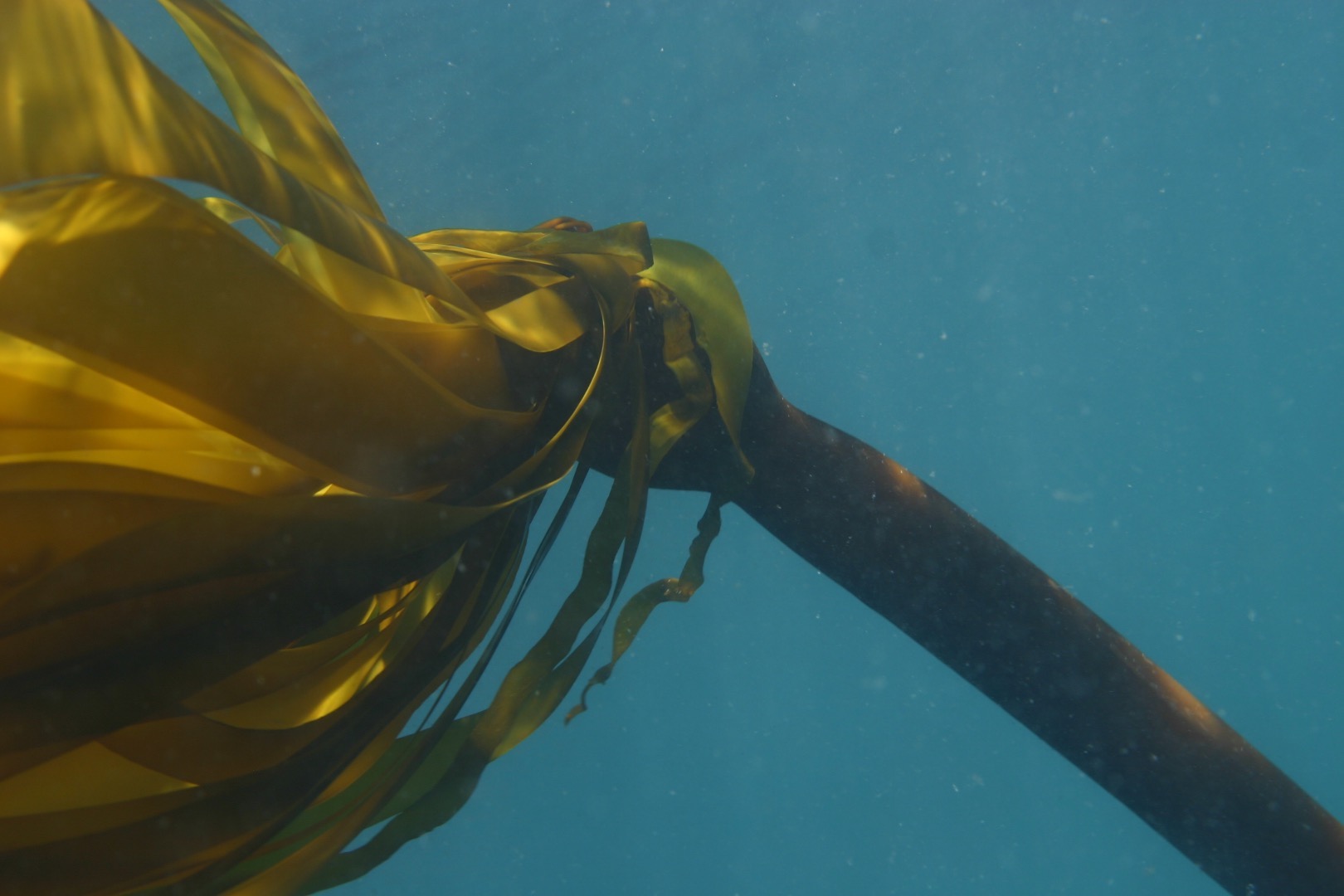
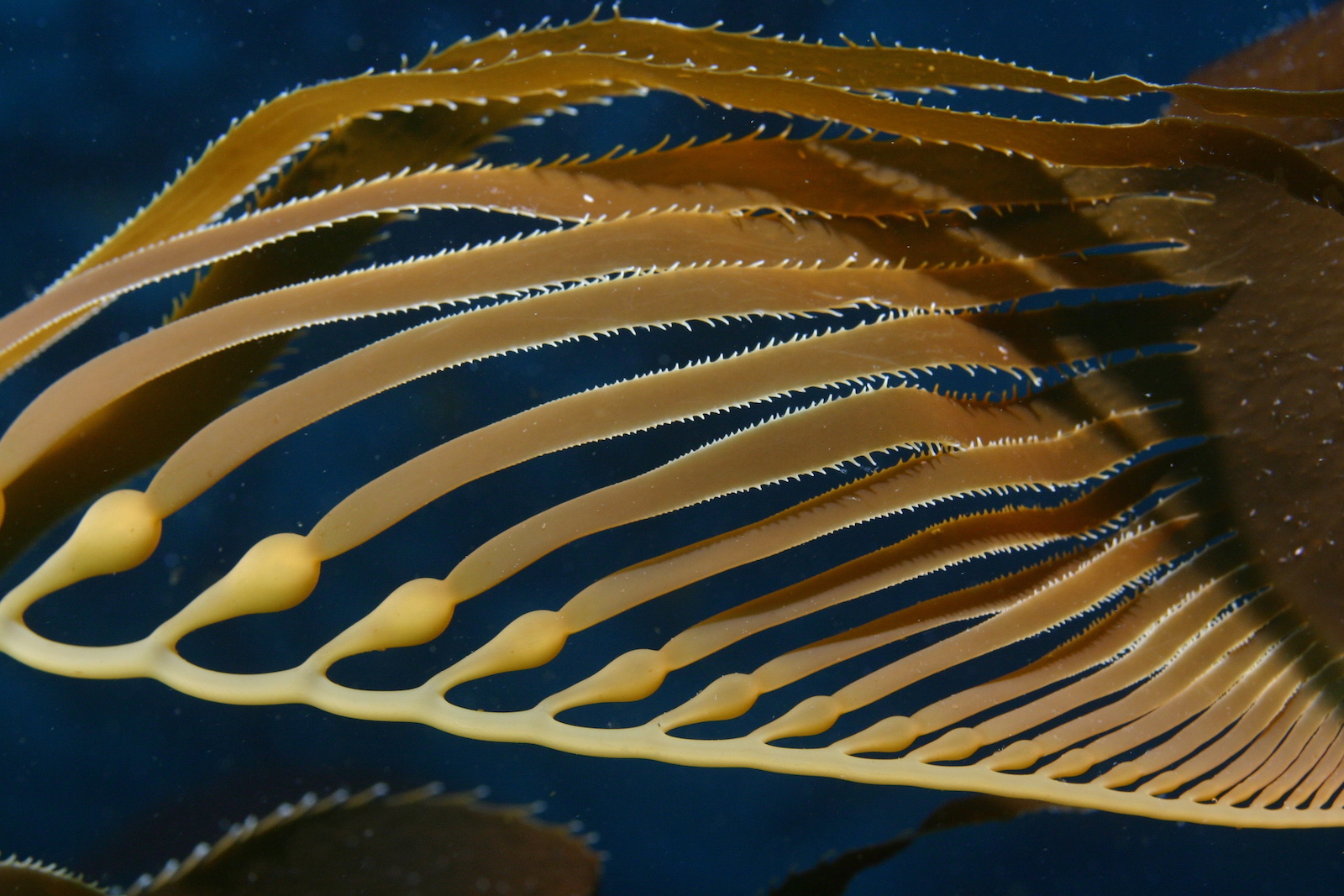
Over the last decade, much of the West Coast’s native kelp, including whip-like bull kelp (left) and lush giant kelp (right), have started disappearing. Photos by Steve Lonhart / NOAA MBNMS
According to Rootsaert, keeping steadfast environmental sanctuary rules firmly in place in Monterey Bay rendered the region’s kelp forests virtually defenseless against marauding purple urchins. “These marine protected areas — which we think of as being wilderness that’s safeguarded to seed the rest of the area that’s not protected — have instead become an urchin barren,” Rootsaert explained on a Zoom call last year with a regional scuba diving club. “They are desolate places.”
In both Fort Bragg and Monterey, efforts to organize culls were ultimately successful — to a degree. After years of inching up catch limits in the region, the state government eventually granted unlimited purple urchin removals for a handful of acres near Fort Bragg in early 2020, allowing Reef Check and other environmental marine groups to organize urchin removals like the one I tagged along on a year ago. In August 2020, Rootsaert was also given approval for an urchin removal project in a portion of the bay just outside Monterey’s main protected areas.
After waging catch limit battles for so long, the resulting culls seemed celebratory. In Fort Bragg, plenty of professionals signed up to help, despite the fact the arrangement only paid commercial divers about half of what they would have made gathering red urchins.
“This is not just a paycheck for them,” said Tristin McHugh, who at the time was Reef Check’s north coast regional manager overseeing the professional collaboration in Fort Bragg. “These are people who have interacted with this environment for their whole lives. They’ve learned to love it and cherish it.
“To see where it’s at right now is devastating for them.”
Even the most enthusiastic purple urchin slayers readily admit that their efforts are merely experiments; urchin removal alone is not enough to bring back the kelp forests. It’s not just that it’s time-consuming — it’s a drop in the proverbial ocean against the hundreds of millions of purps swarming the California coast. And removing urchins doesn’t address the coastal ecosystem’s big underlying problem: warming waters resulting from climate change.
“What we’re observing here basically is what we’ve been promised we would observe,” said James Ray, an environmental scientist with the California Department of Fish and Wildlife. “It’s the collapse of an ecosystem, and then the dissolution of communities that rely on that ecosystem.”
Yet even with that grim reality, support for purple urchin removal varies widely among people who hope to see the kelp forests return. Critics of the hands-on intervention approach, or purp culling, argue that pulling up the urchins could undermine natural corrections to the ecosystem — for example, if a disease (similar to the sea star wasting syndrome) were to come along that could bring down the purple urchin numbers en masse. In that scenario, human-made breaks between urchin colonies could actually slow such a disease’s spread, inadvertently preserving the purps’ dominance.
“What we see going on is just urchins being urchins,” said Kate Vylet, a marine scientist. “They belong in the kelp forest as much as the kelp does.”
There’s also a possibility that untrained divers disturbing purple urchins could trigger bigger spawning events, making the problem more intractable than it already is.

Javier Silva, a member of the Northern California Pomo tribe and former director of the Sherwood Valley Tribal Environmental Program, doesn’t support rushing to intervene further in the kelp forest ecosystem. As much as the current state of his native coastline pains him, he is wary of framing the overpopulated native species as the main threat to the marine environment.
“There’s a cumulative impact happening — something bigger — it’s not one thing,” he said. “I think that humans are a big part of the kelp loss, and I think we just need to stay out of it. We really need to understand it before we jump in headfirst and go after one species. There needs to be a balance.”
The urchin cull proponents argue they’re trying to aid in restoring the balance below the ocean surface. By keeping the purple sea urchins at bay in small patches, they hope to buy kelp forests more time to adjust and, potentially, regrow. After all, kelp can grow incredibly fast — up to two feet per day, in some species. To help them along, some researchers have suggested seeding kelp spores in areas where forests once thrived; others are trying to learn more about the sea star wasting disease that continues to decimate the purple urchins’ predator.
In addition to research efforts, a handful of businesses and projects have sprung up and marketed themselves as solutions to the purple urchin issue. Some collect the purple urchins in tanks, hoping to develop a restaurant market for the smaller purps to replace the now-rare red urchin gonads on dinner menus. Another entrepreneur has touted a natural soil additive with ground urchin as the chief ingredient. And yet another has been experimenting with turning them into rich natural fabric dye.
In the long run, however, even if the reign of the purps ends at some point, it’s hard to say whether the kelp forests will return to their former glory. Marine heat waves, once infrequent, are intensifying and growing more common. There’s no question that Silva is right: People are reshaping the kelp forests through the steady uptick of carbon emissions, whether or not coastal communities choose to actively play God among the underwater invertebrates.
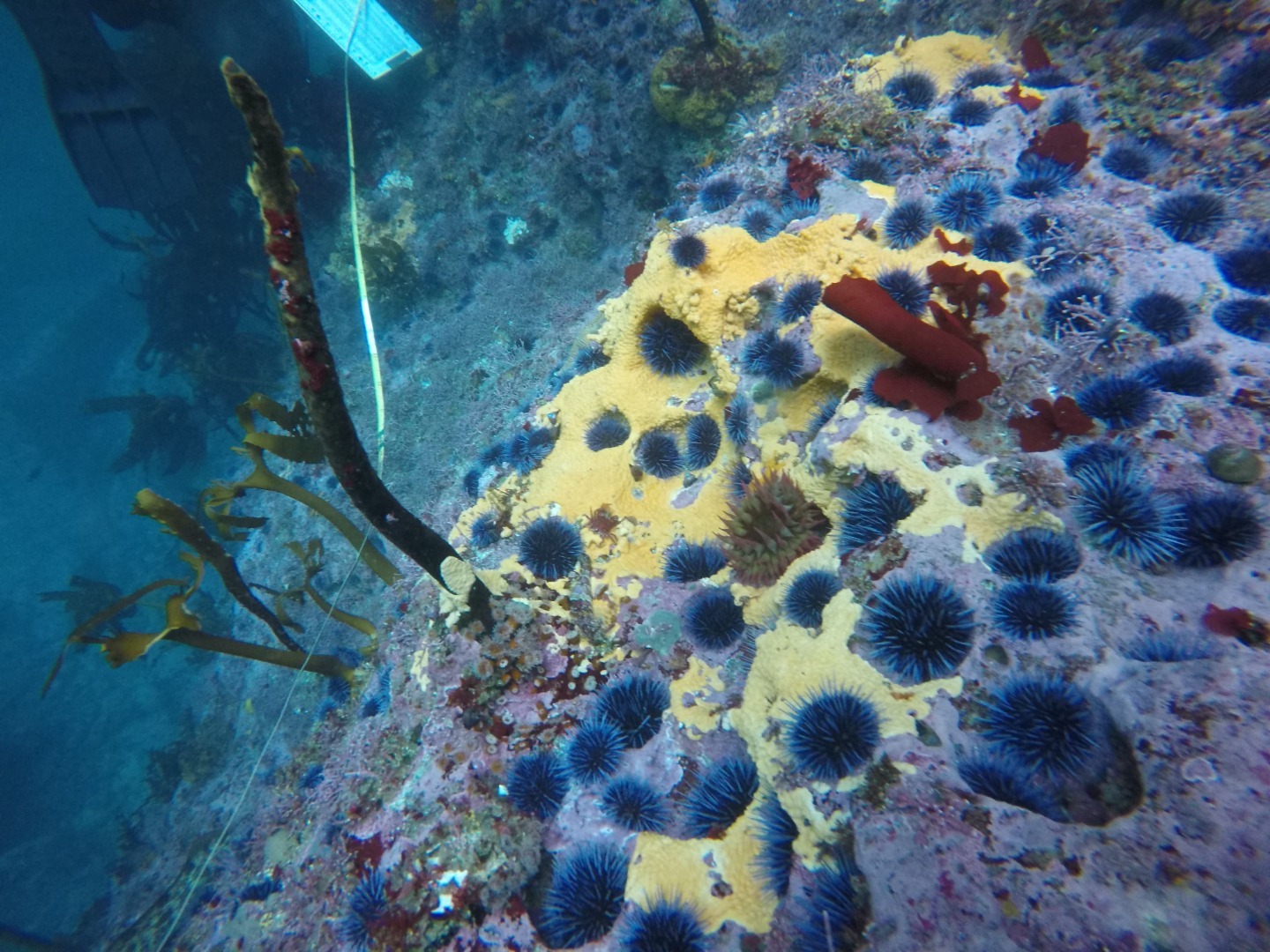
But there is hope too in the stubborn natural tenacity of kelp forests. Fiorenza Micheli of Stanford’s Center for Ocean Solutions estimates that under the right circumstances — a natural form of purple urchin die-off, perhaps, paired with a lasting resurgence of the cooler water in which kelp thrives — those threatened algal cathedrals might once more tower from the ocean floor by the end of the decade. That said, while it’s possible, Micheli admits the chance of those conditions presenting themselves is likely remote.
“I can see the argument for ‘Let’s wait it out,’” she said. “But I don’t know if we want to run this risk of losing this amazing ecosystem.”
This article was made possible, in part, by the Fund for Environmental Journalism of the Society of Environmental Journalists.

